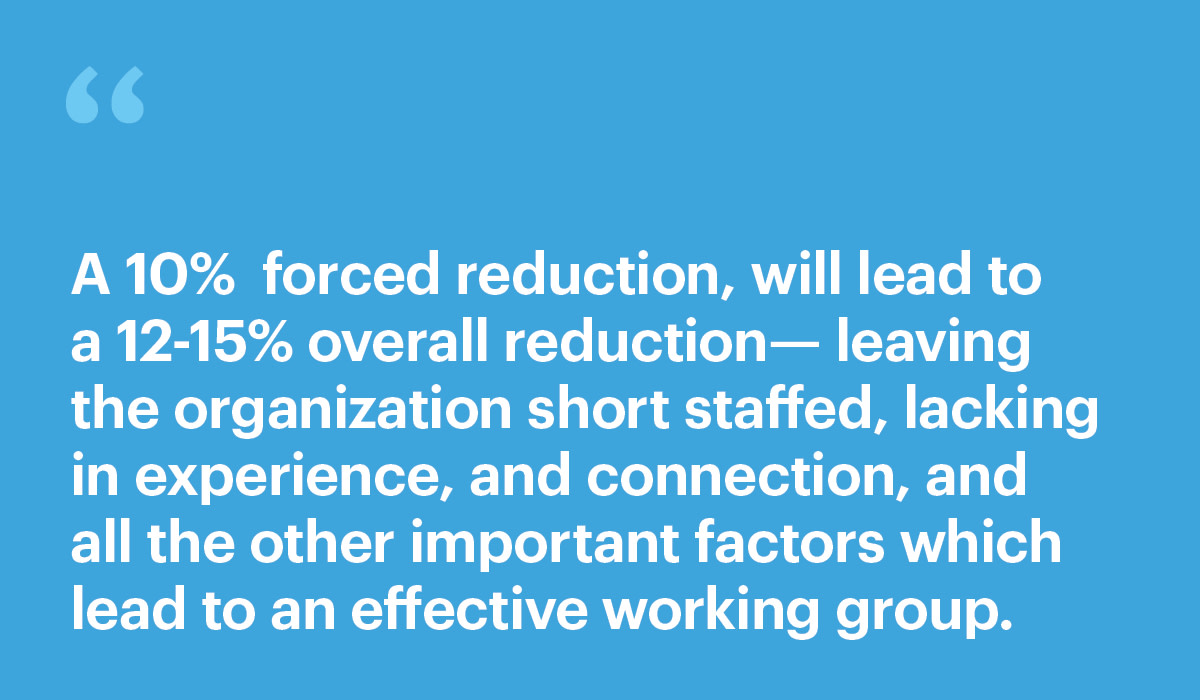How to Prepare for a Recession Part 2: Rightsizing
Recessions make companies consider rightsizing, but layoffs lead to turnover contagion and other damage. This article shows a better way.

The term recession makes many people think of rightsizing or layoffs. In part one of this series we talked about the likelihood of an economic slowdown and its impact on the people aspects of business. We featured the costly example of losing key people and how a narrow view on managing labor costs as part of an economic downturn can do substantial harm to the business over the long term. In part two we are following the same theme and looking at another common—and costly—mistake that organizations make when trying to adjust their workforce to meet new levels of revenue or demand.
Turnover contagion
A large Fintech company recently announced that it was cutting 10% of its workforce, in response to reductions in forecasted demand for its services. Our hope is that this organization actually needed to reduce their employee count by 12-15%, not 10%. This is due to a well researched and documented effect called turnover contagion. Turnover contagion occurs when a set of employees are forced to leave, and an increasing number of other employees choose to leave as a result. So a 10% forced reduction, will lead to a 12-15% overall reduction—leaving the organization short staffed, lacking in experience, connection, and all the other important factors which lead to an effective working group.

Reputational risks of layoffs
It is important to also acknowledge the issues of reputational risk and employer brand damage that come from forced layoffs. The negative impacts to the specific individuals who find themselves without work is a core part of the motivation for writing this piece. Rightsizing may seem a necessary step. When the damage done to individuals, teams, organizations and their business results are fully weighed up, it is clear that laying off people to manage costs is a strategy fraught with challenges that should be an absolute last resort.
An organization is not a machine. It is not possible to simply plug and play people as though they were pieces of the machine. An organization is an ecosystem; every action generates a multitude of reactions, some that are desired, some that are not, and many that are unintended. Turnover contagion is the unintended, but predictable, reaction to an organization terminating the employment of a number of people.
The psychological costs of layoffs
Turnover contagion happens especially when the reason for the termination has nothing to do with the work or contribution of the individual, but comes about due to some level of misjudgment on the financial or business planning side of the organization. It is driven often by the values and the emotions of the people who are connected to those who have been let go. It can be impossible for someone to continue investing their time and effort towards an organization that has broken trust with their friend or colleague.
This deep emotional impact has effects on overall work focus too. More time is spent worrying about when the next cuts will come, whose jobs are safe and why certain groups in the business seem to be immune etc. The reverberations of forced layoffs go wide and deep through a human community, stalling focus, reducing energy, and leading a portion of the community to opt for working elsewhere. These effects do not have line items on the balance sheet, however the outcomes of these effects generate damaging financial impacts.
Unwanted side effects of layoffs or rightsizing
Following this chain of action and reaction it becomes clear how the intended cost reductions that come from forced layoffs soon evaporate when the effects of turnover contagion are included. Far from reducing the workforce to the desired level, the layoffs create vacancies, often for key roles or for experienced staff who have the best options for finding new work. This in turn leads to hiring needs, causing employees to question why hiring has started so soon after layoffs took place etc.
The costs of these spiraling events quickly add up as new hires are paid more, orders or customers are lost due to poor service or network effects, and project deadlines are missed because the person with the key knowledge moved on to another employer. Although it may look like a 10% reduction only impacts a small proportion of the people, organizations are made up of networks: this type of event will impact everyone in the business.
Rightsizing without layoffs
Anyone who is reading this, nodding their head in recognition, will understand the key role that insights about people play in managing through a financial downturn. There are many ways in which forced layoffs can be avoided and any organization looking to reduce overall staff costs should consider these first.
An example from one of our clients in the financial services sector is particularly relevant. The business was removing resources from a shrinking line of business. As part of the process, the people analytics team reviewed historical trends and forecasts for the natural movement of employees within the affected groups.
The client initially planned to terminate the employment of around 5% of the group. The new plan, incorporating the contributions from the people analytics team, achieved the required cost reduction without layoffs. Natural turnover, retirements and internal movement meant that the organization absorbed the people changes in line with the budget constraints. Notably, this project put the people analytics team on the CEO’s radar, who understood the value of not having to present to his internal stakeholders, the market, and the customer community they served, that the organization had laid off employees.
Salary reductions
Further examples of ways to avoid layoffs were prevalent in the 2007/2008 financial bust. The majority of organizations still went down the layoff path. However several followed the path of holding onto all of their people and asking everyone to reduce their salary instead. Importantly where these organizations had hourly employees this population was typically excluded with the executives and management reducing their pay levels to a greater degree than the individual contributors in the business.
You may think this is not legal. This is not correct. Employment is a contract between two parties and it is always possible to renegotiate the terms of the contract. You cannot force people to take less money; that is a breach of contract. However you can ask people to agree to a change in contract conditions, explaining why it is necessary and what you hope it will bring to the overall business.
The people side of cost reduction
There is no way to provide a step by step blueprint through which every organization can navigate their needs to reduce their workforce costs. We recognize that there are always business situations that require these types of cost reductions. The core message from the examples shared above is for the need to look at cost decisions about people through a lens of the people side of the business.
Deciding how to achieve a cost reduction must be a shared endeavor at the strategy and planning level between operations, finance and people analytics. Only in this way can the deep knowledge about the work, how it gets done, which people are crucial to the work, and how they are connected be integrated into the approach taken to reducing costs.

Creative ways to adjust costs, and the subsequent avoidance of negative consequences benefits the organization, its shareholders, and its employees. Conversely, the public backlash and business impacts of doing layoffs badly is becoming a constant source of media attention.
In preparing to navigate an economic downturn it is vital that you have, at your fingertips, the knowledge about your people that you need. Making decisions about people and their costs without this type of insight will cost you more money and may even cost you your business.
To learn more, download the white paper How to Recession Proof your Business: Rethink your talent strategy now to prepare your company to ride out the storm.
Interested in learning more about Visier? Schedule a demo today.


